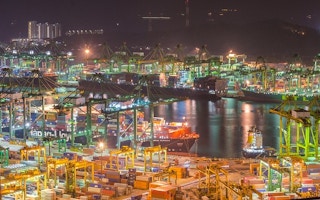Coastal areas around Southeast Asia suffer the most from pollution caused by ship traffic, according to a global study that estimates shipping emissions based on real-time, local activity for the first time.
The study, published this month (19 August) in Atmospheric Environment, sheds light on forces at play in a region where shipping pollution is believed to cause up to 24,000 deaths a year.
The researchers put together a detailed picture of the emissions of around 300,000 commercial vessels for the year 2015. They found that three of the six most polluted harbours – Singapore, Hong Kong and Shanghai – are in Asia.
The Malacca Strait, the Eastern China Sea and the Yellow Sea have the world’s highest concentration of shipping emissions, the authors said.
“
In some harbour areas shipping can cause severe health effects and premature deaths.
Lasse Johansson, research scientist, Finnish Meteorological Institute
They used data from the global Automatic Identification System (AIS), which requires all ships larger than 300 tonnes to regularly report their position. This is significant because it records where ships have been and when, allowing a more precise estimate of shipping pollution compared to previous studies.
The team from the Finnish Meteorological Institute joined around 8 billion AIS data points to cover more than a billion kilometres travelled by commercial ships worldwide in 2015.
By combining this data with information on vessel size, engine type and fuel used, they managed to draw a high-resolution image of shipping pollution, particularly highly dangerous small-particle pollution less than 2.5 micrometres in diameter.
The consequences of inhaling these pollutants are serious, says lead author Lasse Johansson, a research scientist at the institute. “In some harbour areas shipping can cause severe health effects and premature deaths.” A 2007 study showed that small-particle emissions from ships lead to an estimated 60,000 premature deaths globally each year.
The situation in Southeast Asia is compounded by the large number of unregistered local vessels, according to Johansson, which were not included in the study.
Globally, the researchers identified 76,000 vessels for which no technical data, such as the ship’s size or type of fuel used, could be obtained.
Together, these vessels travelled a distance that accounts for only 3.5 per cent of all recorded shipping kilometres, but Johansson says their local impact should not be underestimated. “Near coastal cities the [emission] contribution of these vessels can still be larger than the overall contribution might suggest,” he says.
Registered ships were responsible for 93 per cent of small-particle emissions and 91 per cent of the carbon dioxide emissions covered by the study.
Part of the large concentration of shipping emissions in the region is explained by the rapid economic growth of countries in the Association of Southeast Asian Nations (ASEAN),which is fuelled by export of consumer goods.
The ASEAN nations’ GDP grows by an average 6 per cent annually, according to the OECD, with 74 per cent of the region’s exports travelling by sea to non-ASEAN countries.
Southeast Asia also suffers from high shipping emissions because its location exposes it to the densest and most frequent shipping traffic in the world.
Aretha Aprilia, a civil engineer from Indonesia and former coordinator at the UN Environment Programme, tells SciDev.Net that regional efforts to curtail shipping emissions have been “a huge challenge”.
“To date, not much attention has been given to the issues regarding emissions from shipping, and this needs to shift,” says Aprilia. “It is a prerequisite to have more legally binding regulations that are enforced from the countries.”
The study suggests that pollution control areas, where carbon dioxide and fine particle emissions from ships are subject to strict rules, can work if enforced. “Yet these can be costly for ship owners,” says Johansson.
He suggests that poorer nations should look at alternatives, like re-routing large ships and planning their infrastructural development in order to mitigate pollution.
“For instance in Helsinki, where I live, the cargo terminals were relocated well outside of the city.”
This article was originally published on SciDev.Net. Read the original article.










